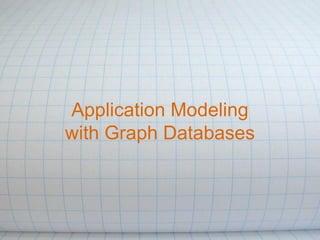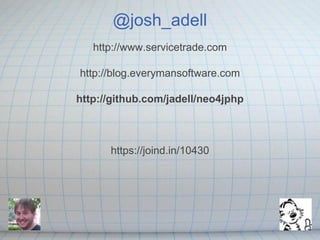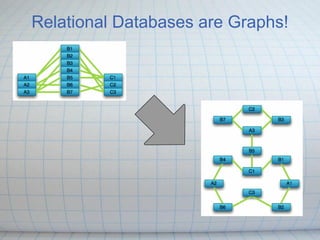Application modelling with graph databases
- 1. Application Modeling with Graph Databases
- 3. The Problem
- 4. The Solution? > -- First degree > SELECT actor_name FROM cast WHERE movie_title IN (SELECT DISTINCT movie_title FROM cast WHERE actor_name='Kevin Bacon') > -- Second degree > SELECT actor_name FROM cast WHERE movie_title IN (SELECT DISTINCT movie_title FROM cast WHERE actor_name IN (SELECT actor_name FROM cast WHERE movie_title IN (SELECT DISTINCT movie_title FROM cast WHERE actor_name='Kevin Bacon'))) > -- Third degree > SELECT actor_name FROM cast WHERE movie_title IN(SELECT DISTINCT movie_title FROM cast WHERE actor_name IN (SELECT actor_name FROM cast WHERE movie_title IN (SELECT DISTINCT movie_title FROM cast WHERE actor_name IN (SELECT actor_name FROM cast WHERE movie_title IN (SELECT DISTINCT movie_title FROM cast WHERE actor_name='Kevin Bacon'))))
- 5. The Truth Relational databases aren't very good with relationships Data RDBMs
- 6. Try again?
- 8. Warning: Computer Science Ahead A graph is an ordered pair G = (V, E) where V is a set of vertices and E is a set of edges, which are pairs of vertices in V. If vertex pairs in E are ordered, the graph is directed.
- 9. Property Graph Nodes have properties and labels Relationships have properties, a type and direction Relationships are first-class entities Queried just like Nodes Indexes Unique constraints new in Neo4j 2.0!
- 11. Relational Databases are Graphs!
- 13. Modeling "Whiteboard-Friendly" Nouns => nodes, Verbs => relationships
- 14. Back to Bacon MATCH p = shortestPath( (r:Actor) - [*] - (b:Actor) ) WHERE r.name=ŌĆØKeanu ReevesŌĆØ AND b.name=ŌĆØKevin BaconŌĆØ RETURN p, LENGTH(p)/2
- 15. Social MATCH (:Person {name:"Josh"})-[:FRIEND_OF]-(p:Person), (m:Movie) WHERE NOT (p)-[:HAS_WATCHED]->(m) RETURN COUNT(p) as not_seen, m ORDER BY not_seen DESC LIMIT 1
- 16. But Wait...There's More! Mutating (insert, update ~ create, merge) Indexing (auto, full-text, spatial) Batches and Transactions Embedded (for JVM) or REST
- 17. Where fore art thou, RDB? Aggregation Ordered data Truly tabular data Few or clearly defined relationships
- 18. Questions?
- 19. Resources ŌŚÅ http://github.com/jadell/neo4jphp ŌŚÅ http://neo4j.org ŌŚÅ Jim Webber - A Little Graph Theory for the Busy Developer ŌŚŗ http://vimeo.com/76713692 - Jim Webber ŌŚÅ http://joshadell.com ŌŚÅ https://joind.in/10430














![Back to Bacon
MATCH p = shortestPath( (r:Actor) - [*] - (b:Actor) )
WHERE r.name=ŌĆØKeanu ReevesŌĆØ AND b.name=ŌĆØKevin BaconŌĆØ
RETURN p, LENGTH(p)/2](https://image.slidesharecdn.com/applicationmodellingwithgraphdatabases-cypher-140117203400-phpapp02/85/Application-modelling-with-graph-databases-14-320.jpg)
![Social
MATCH
(:Person {name:"Josh"})-[:FRIEND_OF]-(p:Person),
(m:Movie)
WHERE NOT
(p)-[:HAS_WATCHED]->(m)
RETURN COUNT(p) as not_seen, m
ORDER BY not_seen DESC LIMIT 1](https://image.slidesharecdn.com/applicationmodellingwithgraphdatabases-cypher-140117203400-phpapp02/85/Application-modelling-with-graph-databases-15-320.jpg)



